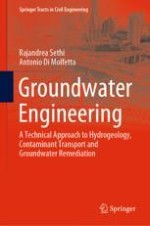Abstract
Aquifer tests are the most appropriate method to determine the hydraulic behavior of an aquifer and the distribution of the hydrodynamic parameters that govern such behavior. This chapter illustrates the different type of aquifer tests (i.e., pumping, recovery and slug tests) and how to plan, execute and interpret them. Pumping tests consist in measuring the drawdown induced by the extraction of water from a well at a constant discharge rate in one or more observation points. They allow to first identify the hydraulic behavior of the aquifer, and thus to classify it as confined, leaky or unconfined, and then to determine, via a type curve matching method, the aquifer’s horizontal hydraulic conductivity, transmissivity and storativity. In the case of leaky aquifers, also the leakage factor can be calculated; and in the case of unconfined aquifers, the effective porosity and the vertical hydraulic conductivity can also be derived. Clearly, this interpretation relies on a number of ideal hypotheses being satisfied; this chapter also illustrates how to interpret pumping tests in the presence of factors that cause a deviation from the ideal behavior (e.g., finite, as opposed to infinitesimal, well radius and volume; partially penetrating well; presence of recharging or impermeable boundaries; inconsistent pumping rate; permeability damage close to the well). During recovery tests, residual drawdown measurements are carried out following the interruption of the pump at the end of a constant discharge pumping test. Theis’ recovery method, based on the superposition principle and normally used for the interpretation of the test, allows to determine the transmissivity of an aquifer. The last type of aquifer test, i.e., the slug test, consists in inducing an instantaneous variation of the static water level in a well or piezometer, and subsequently measuring the recovery over time of the undisturbed level in the same well. This method is used to determine the hydraulic conductivity of the aquifer in proximity of the well. In this chapter, the most common interpretation methods are presented, as well as the strategies to overcome limitations due to the existence of factors that cause a deviation from the ideal behavior. Finally, a suite of correlation-based, laboratory, and field methods available for the determination of an aquifer’s hydrodynamic parameters in alternative to aquifer tests are presented, and the applicability to different aquifer types and situations of each method, as well as their reliability is discussed.
